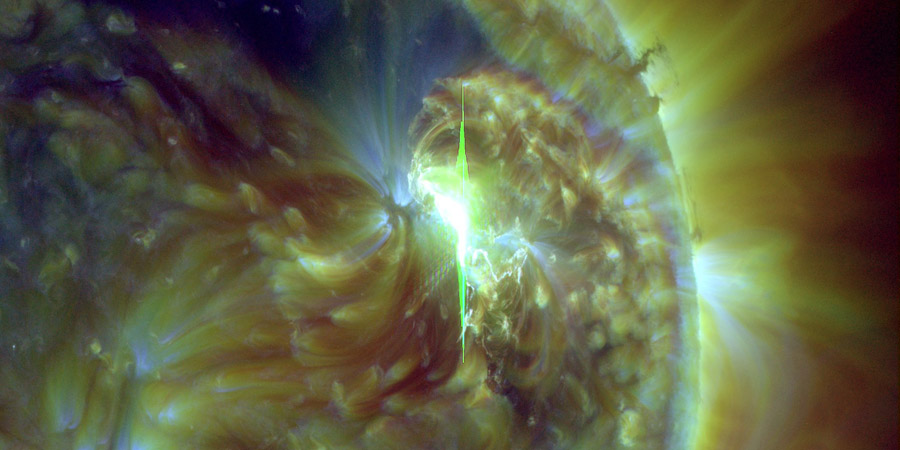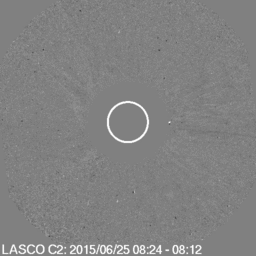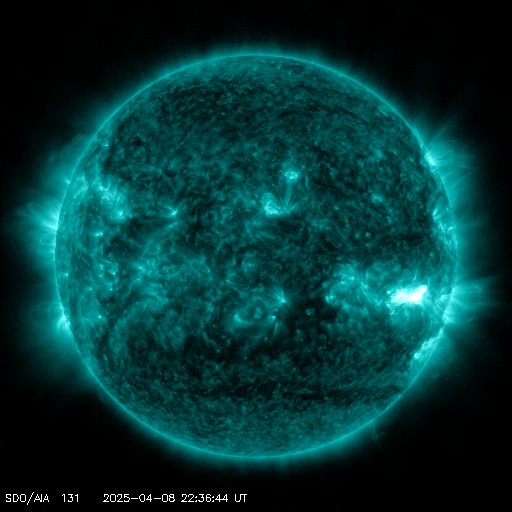M7.9 solar flare
Thursday, 25 June 2015 18:16 UTC

Yesterday's coronal mass ejection arrival (CME) has been largely disappointing and it took a while before the direction of the IMF turned southward. While we did reach the moderate G2 geomagnetic storming threshold earlier today, we can conclude that this event nonetheless was a disappointment as the expected G3 geomagnetic storming threshold was never within reach. To make matters worse, this night we came to the conclusion that sunspot region 2371 is in decay and that it is now only a shadow of it former self. It's delta structure is no longer there as it has ripped loose from the trailing sunspot cluster. The chance for even a low-level M-class solar flare seemed low. But boy, sunspot region 2371 showed us this morning that it doesn't even need a delta structure to produce a strong solar flare. It surprised us with an M7.9 (R2-moderate) solar flare that peaked at 08:16 UTC.
Strong M7.9 solar #flare from #sunspot region 12371 - Follow live on http://t.co/XHATH0OOfT pic.twitter.com/roltn3J1Ac
— SpaceWeatherLive (@_SpaceWeather_) 25 juni 2015
It was right away clear with the help of SDO imagery that also this solar flare launched a coronal mass ejection, something which was confirmed not much later by SOHO/LASCO imagery. Sunspot region 2371 is now on it's way towards the west limb so it was clear that this plasma cloud wouldn't head towards Earth straight on like the 21 June coronal mass ejection did which produced the severe G4 geomagnetic storm on 22 and 23 June. If we take a look at SOHO imagery (see the animations below) we see a full halo coronal mass ejection but the bulk of this coronal mass ejection is heading well north-west of our planet and will thus miss us. When you look closer you can see that there is a fainter halo outline as well so we can conclude that a portion of the cloud will likely interact with our magnetic field but we should not expect much more than (yes here come those famous words) a glancing blow.


Animations: SOHO/LASCO C2 and C3 animations showing the coronal mass ejection from today's M7.9 solar flare.
CACtus reports that this coronal mass ejection left the Sun at a speed of 1.600 km/sec which is fairly high and the fastest coronal mass ejection launched by this sunspot region. However, this high speed consists of the bulk of this coronal mass ejection that is not coming towards us. The portion of the cloud heading towards Earth is slower as you can see how the halo doesn't expand so fast in the south-east. We estimate this part of the plasma cloud to be around 1.000km/s. Factoring in the high ambient solar wind speed we come to the conclusion that this coronal mass ejection will have a travel time from the Sun to Earth of about 50 hours meaning we can expect an impact time of about 10:00 UTC on 27 June with a plus/minus of six hours. A minor G1 geomagnetic storm will likely follow with a chance for a moderate G2 geomagnetic storm if the direction of the IMF cooperates. The chance for aurora on middle latitude locations is small. A lot will depend on the strength of the IMF and the direction it carries. We have seen before this week how two different CMEs can have a very different IMF strength within them.
Thank you for reading this article! Did you have any trouble with the technical terms used in this article? Our help section is the place to be where you can find in-depth articles, a FAQ and a list with common abbreviations. Still puzzled? Just post on our forum where we will help you the best we can!
Current data suggests there is a slight possibility for aurora to appear at the following high latitude regions in the near future
Gillam, MB, Iqaluit, NUNuuk
Reykjavik
Latest news
Latest forum messages
Support SpaceWeatherLive.com!
A lot of people come to SpaceWeatherLive to follow the Sun's activity or if there is aurora to be seen, but with more traffic comes higher server costs. Consider a donation if you enjoy SpaceWeatherLive so we can keep the website online!

Latest alerts
01:45 UTC - Geomagnetic activity
Active geomagnetic conditions (Kp4) Threshold Reached: 01:41 UTC
Wednesday, 9 April 2025
08:12 UTC - Hemispheric Power Index
The OVATION model predicts the Hemispheric Power Index to reach 76GW at 08:57 UTC
02:00 UTC - Geomagnetic activity
Minor G1 geomagnetic storm (Kp5) Threshold Reached: 01:45 UTC
Tuesday, 8 April 2025
23:57 UTC - Hemispheric Power Index
The OVATION model predicts the Hemispheric Power Index to reach 50GW at 00:44 UTC
22:42 UTC - Solar flare
Moderate M1.57 flare
Space weather facts
| Last X-flare | 2025/03/28 | X1.1 |
| Last M-flare | 2025/04/08 | M1.5 |
| Last geomagnetic storm | 2025/04/06 | Kp5 (G1) |
| Spotless days | |
|---|---|
| Last spotless day | 2022/06/08 |
| Monthly mean Sunspot Number | |
|---|---|
| March 2025 | 134.2 -20.4 |
| April 2025 | 148.6 +14.4 |
| Last 30 days | 139.3 +3.1 |





